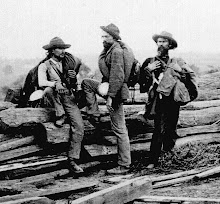 One of the darkest secrets of the Old West was brought into the light and examined this weekend by descendants of a California-bound wagon train which met its end at the hands of Mormon militia and Paiute Indians at a place called Mountain Meadows in 1857.
One of the darkest secrets of the Old West was brought into the light and examined this weekend by descendants of a California-bound wagon train which met its end at the hands of Mormon militia and Paiute Indians at a place called Mountain Meadows in 1857.Covered up in a conspiracy which put the blame for the deaths of 120 men, women, and children on local Indians and shook the Mormon faith to its very core, the Mountain Meadows Massacre has been the subject of heated debate, accusation, and retribution for 150 years.

Descendants from both sides of the tragedy met some 30 miles north of St. George, Utah to commemorate the incident Saturday. An honor guard in period uniforms fired a salute in tribute of the victims, cut down by bayonets and bowie knives in a dark plot hatched by Mormon extremists against the Fancher Party, by all accounts an innocent band travelling through the territory in violation of martial law imposed by Mormon Leader Brigham Young.
Descendants of those who committed the massacre, only one of whom was ever successfully prosecuted and subsequently shot, also attended, as did historians with The Church of Jesus Christ of Latter-day Saints. Descendants of massacre victims (seven children from the slaughtered party were taken and "adopted" by Mormon families) were also present.
They heard about efforts to preserve the grave site through a master plan compiled by the descendant groups and LDS Church, which has been acquiring property around the site and plans to buy more.
The LDS Church and descendant groups are meeting to preserve the site for posterity.
In an interesting case of self-analysis the church has expanded its holdings from the mere 2.5 acres where the current memorial is located to 700 acres - including more than 200 acres that would have been subdivided near the meadows.
Sixteen acres recently acquired by the church is believed to be the location where the bones of men killed at the massacre were buried a year later. The church may purchase another site where children and women could be buried, if pending investigations reveal the bodies are there.
The Mormon church has opened up about Mountain Meadows since the archives of the church were opened to scholars. During the 150th anniversary at the site, apostle Henry B. Eyring was the first church leader to acknowledge the massacre was carried out by local church leaders.
















